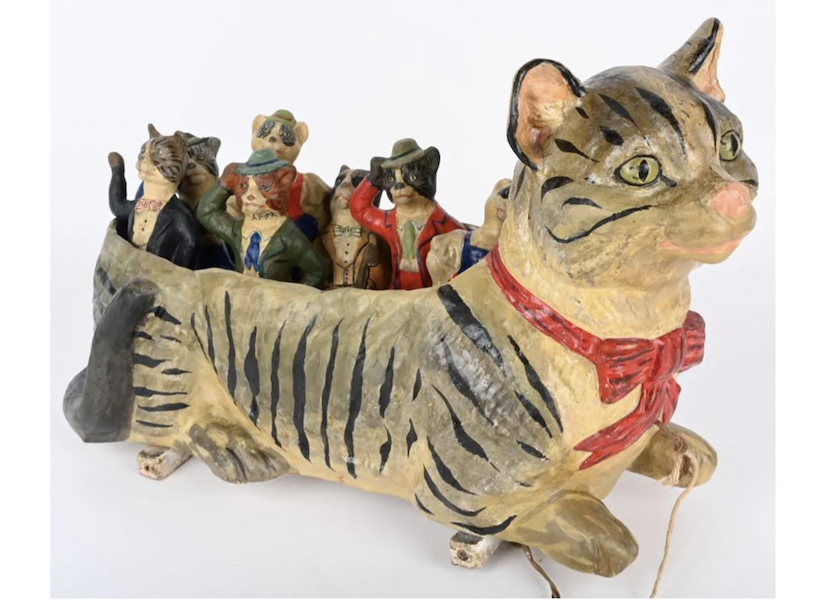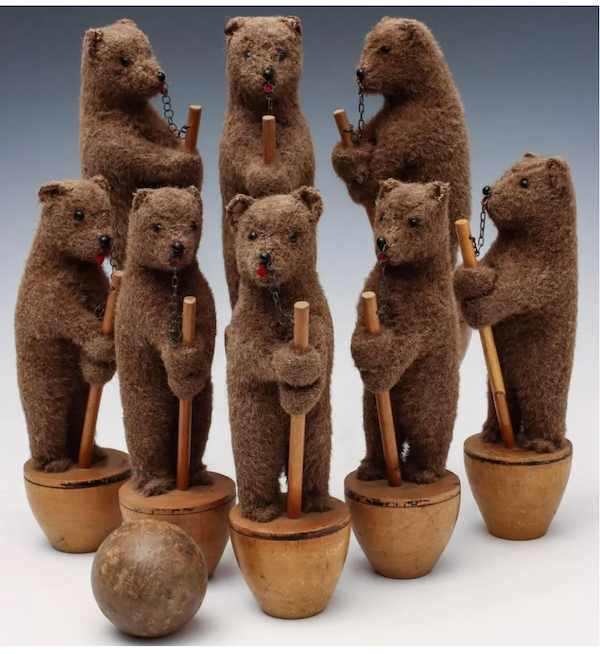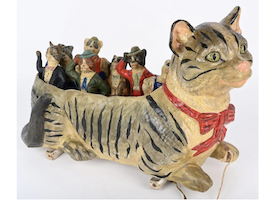
NEW YORK — A popular bowling game in Europe during the Middle Ages and in English inns for many years, skittles, aka ninepins, involves throwing a ball at nine pins arranged in rows. Vintage and antique skittles sets continue to turn the heads of 21st-century collectors.
The game went by different names in different countries. There are 14th-century French manuscripts referring to a game of Kayles, and it has been called Closh in other places, but the game basics are consistent. Whether throwing the ball, or “cheese” as it is sometimes known, from a distance or up close (a practice dubbed “tipping”), the winner was the first person to hit the target number of pins. Sometimes a club would be thrown at the skittles, but most antique skittles sets seen on the market today come with a ball.
Author Joseph Strutt notes that the earliest examples of skittle pins were made from animal bones, and he quotes a line from a period play in which a character threatens to “cleave you from the skull to the twist and make nine skittles of thy bones.”
Skittles pins have been made from a variety of materials, but most typically from wood. They come in a wonderfully whimsical range of forms — mostly animals, although figural skittles sometimes appear. Antique examples, when they come in full sets and are sold with the matching container, are highly sought after, but even partial sets will do well assuming they’re in good condition, take a desirable form and possess detailed decoration.

Steiff, a German toy maker renowned for its button-in-the-ear teddy bears, also made skittles sets in animal forms, starting in 1892. In December 2020, Soulis Auctions offered a remarkably well-preserved circa-1900 set of eight standing bears, which Steiff described as “dancing” bears, covered in worsted wool and set on wooden bases. It sold for $14,000 plus the buyer’s premium despite the fact that it contained eight figures instead of the full nine. Each bear had black shoe button eyes, a black bead nose with chain and a red felt tongue. The bears lacked the trademark buttons in their ears, a practice that was implemented by Steiff in 1904, indicating that the skittles set was made earlier than that date.
While Steiff produced several charming skittles sets, other German makers released well-made and appealing interpretations of the game gear. Unfortunately, there is either scant information about them or their names have been lost to history, as many of these sets were not trademarked or signed. A colorful and folky German cat skittles set brought $13,500 plus the buyer’s premium in October 2021 at Milestone Auctions. The cat container, set on cast iron wheels, is in the form of a striped cat having pink ears and a pink nose and wearing a red ribbon around its neck. Inside its hollowed-out body is space for the skittles, which were dressed as cats in fancy attire.

Equally delightful is a German-made dog skittles set that fetched $10,000 plus the buyer’s premium in November 2018 at Bertoia Auctions. The black and white dog container on wheels, wearing a red collar on its neck and fitted with glass eyes, holds nine well-dressed dog pins of varying breeds and outfits.
Farmyard animals were an especially popular motif for skittles sets. Boasting crossover appeal with circus collectors is a set of nine skittles of barnyard fowl dressed as clowns inside a lavishly detailed chicken container on wheels. The German made-set earned $11,000 plus the buyer’s premium in November 2022 at Bertoia Auctions. Measuring 16in long, the set includes skittles shaped like ducks and chicks that wear the pointy hats and ruff collars that are typically part of a clown’s costume.

Contemporary artists have been inspired by European papier mache and composition Halloween decorations and toys that were exported to America around the turn of the previous century. California folk artist Jack Roads created a skittles set in the motif of veggie people — human beings that look like vegetables — that was common among German-made Halloween papier mache candy containers during this era. His set featured a large jack-o-lantern container on wheels that held nine colorful pins in the forms of various vegetables that had big eyes and wide, toothy grins. The set realized $5,500 plus the buyer’s premium in October 2018 at Dan Morphy Auctions.

The market for antique games is a fine one for collectors to try as it offers a gratifyingly large variety of choices, both in price and style. Skittles sets are especially popular as they don’t demand much display space and their colors and folksy charm make them ideal conversation pieces.


